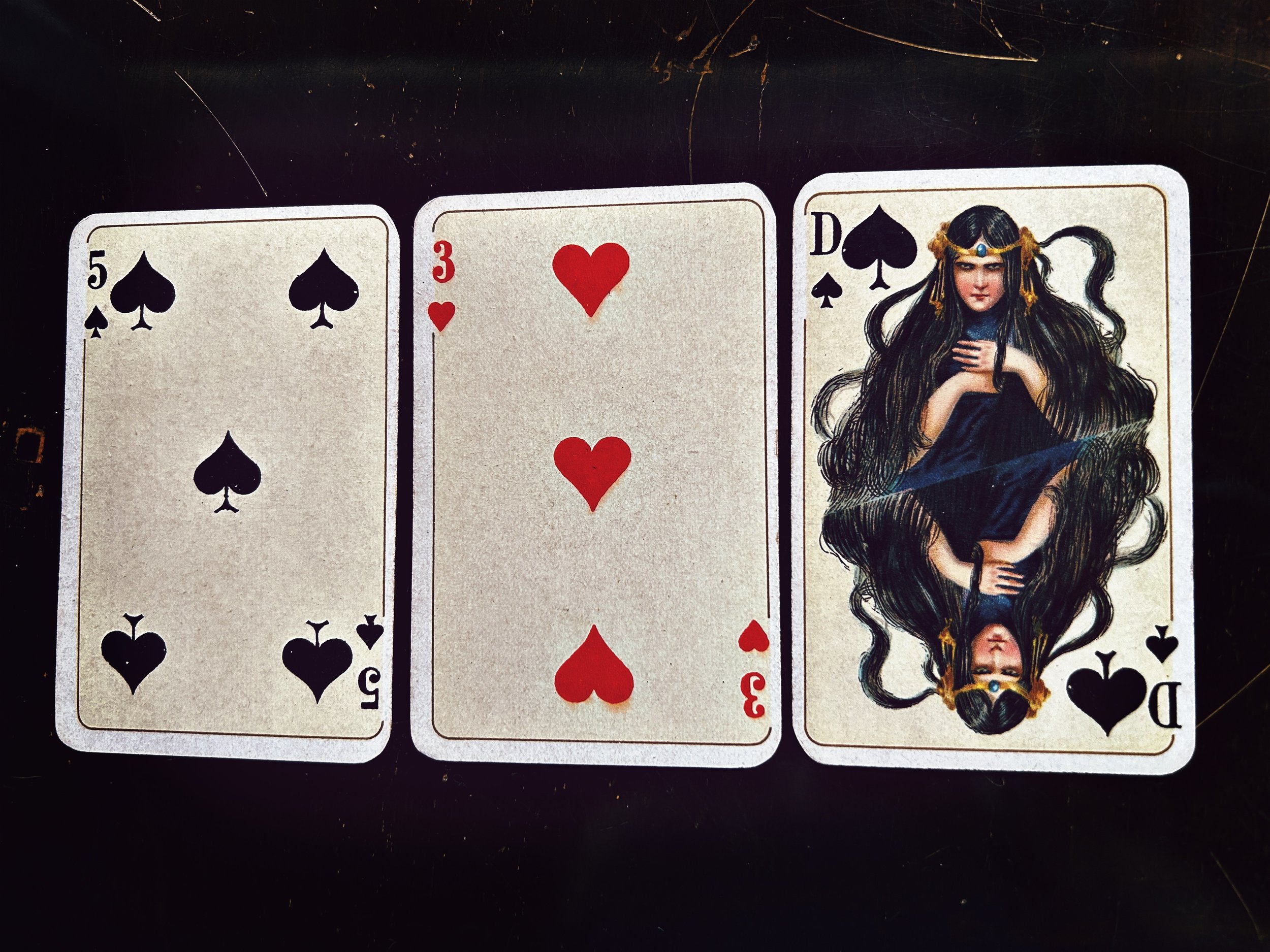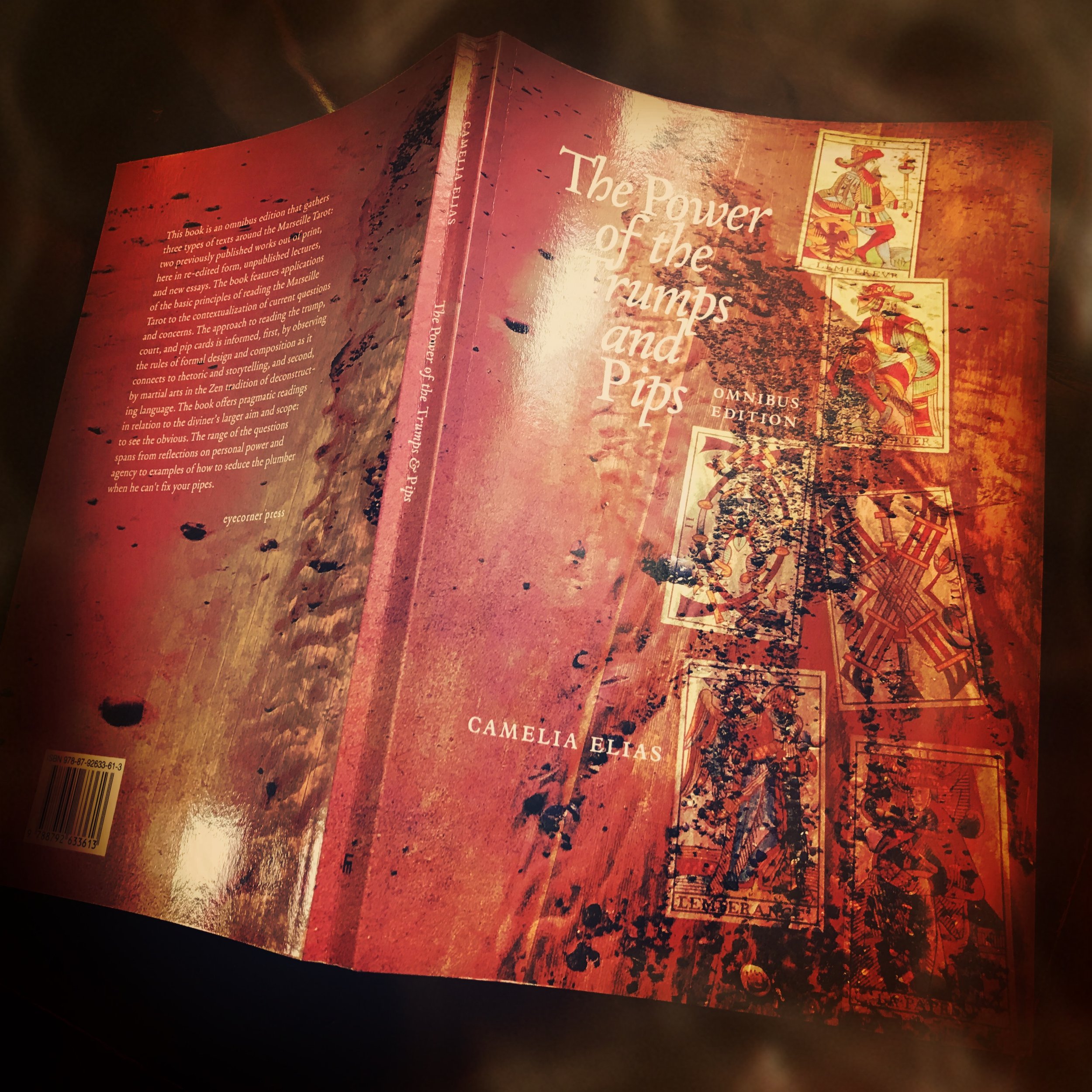Yes, but
A few notes on how to read the court cards in connection with yes/no questions. You don’t. As you’re here to read like the Devil by using your logical brain and deductive faculties, you know already that one of the first rules you obey is that of color. If the card in the final position is a red one, then the answer is yes. For the most part.
But what if the final card is a black court card? Is the answer no? Not necessarily. Court cards are people, not relations, so depending on the nature of the question, the court card in the final position will always tell you something about an other person influencing the yes or the no of the situation. Take the example below featuring 5 Spades, 3 Hearts, the and Queen of Spades.
If the question is: ‘does this woman love me?’ then the answer is yes, especially if the significator is the Queen of Spades herself. The 3 Hearts card tells us that there’s a sharp interest in the querent coming from the woman in question, and she is responsive to the querent and to what otherwise can also be perceived as a sick infatuation with her – the 5 indicates the body, here, an illness that the querent suffers from; with the 3 Hearts, presumably an illness due to the impatience of love.
If the querent is a man whose significator is the King of Clubs, who wants to know whether the Queen of Diamonds, the other significator, loves him, the answer is still yes, but the following would need to be said: ‘the Queen of Diamonds (not present in the spread) is quite interested in the King of Clubs (also not present in the spread), but she listens to the advice of someone, the Queen of Spades who is present in the spread, and who is not in the King’s corner.’ In the case of no significator for the woman, the answer is also, ‘yes, but she responds more to your own projection of love’ – we say this because of the presence of the 5 of Spades in the spread.
Now, if we had a different question coming from a woman who wants to know: ‘is my mojo working?’ – in the sense of her wishing to hold someone specific in her power – then the answer would be yes, because of the nature of the question par excellence. Here we look at the function of the Queen in general first, and then at her function as the Queen of Spades, in particular. Generally the Queens represent truth, the Kings power, and the Jacks the go-between, hence by extrapolation, thoughts. The Queen of Spades, by virtue of the power of her suit to cut through everything, may represent a truth that disturbs or one that questions truth. Here, insofar as the 3 Hearts precedes the Queen of Spades, we could argue that the truth of this Queen is ‘well-aspected.’
Given the nature of the question falling more under the magical realm where we deal with projections of fantasy that are not only willed but that also become real, we take the Queen of Spades, the Lady of Fate herself, as a strong affirmation of the possibility that the mojo is indeed working. If anyone can hold anyone else in their power the magical way, then that would be the Queen of Spades.
Now, as in the first scenario, given also that here the string begins with 5 Spades indicating a case of illness related to the querent, we may question the truthfulness of the extent to which our querent’s mojo is working in her best interest. Magically speaking, it’s definitely working, but is it good for her? While the Queen holds power over the other, she is also tied. Consequently she is prone to making herself sick by obsessing over it.
This would be the sort of thing that the reader, if she wants to help, would point to, or would have to bring into question. But some readers prefer to stay neutral and not ask anything beyond the scope of the reading. I admit that I’m one of those. I don’t like yakking too much when I divine with the cards, nor do I like assuming too much. However, as we’re dealing with a red card here, we could also argue that there’s pleasure involved in exercising this, otherwise unhealthy, power and keeping it in line, as it were, if we consider the visuals on the cards of the 3 Hearts.
To keep it simple then, given also the indication from the cards, the final answer would be to say, ‘your mojo is working, but you’re also a (sadistic) victim.’ So the basic rule of thumb for the color code is upheld: a black card ends the string, bad outcome.
My advice for tricky situations such as these, when we have to figure out what to make of the court cards in the final position particularly for yes/no questions, is to think of the court cards as appositions of the conditional type, as when we say, yes… but, or no… but. Used in this way, the court cards in the final position can be seen as full stops to a sentence, just as we’ve seen in the earlier example when we assigned the Clubs the punctuation honor. Or else we can think of what kind of gravity they might carry, that is to say, the gravity in tone when we approach a point we want to make and hence lower our voices for it in order to mark the significance of what we’re saying. But this situation is mainly relevant when we have many cards on the table. For the quick 3-card draw, we stick with the most obvious and urgent.
Deck: Dondorf, Otto Tragy Jugend Spielkarten, Ver. Stralsunder Spielkartenfabrik, 1910
*
The courts
My book dedicated to the reading of playing cards has a lot to say about the four suits, but The Power of the Trumps and Pips explores more poignantly the court cards, both individually and as they appear next to the trumps.
The class
See the playing cards module at Aradia Academy.




